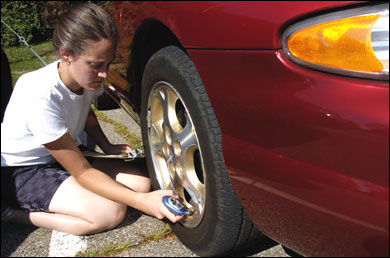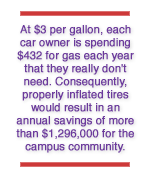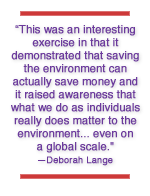|
|
|||||
|
|
Save Gas, Money and the Environment with Properly Inflated Tires
Want to save hundreds at the gasoline pump? It's easy. Instead of hunting for the best price in town, try checking the air pressure in your tires. Proper air pressure results in better gas mileage, which at $3 per gallon could save you as much as $432 per year, according to an informal study conducted by Carnegie Mellon students last spring.
And if money isn't a big enough incentive, how about helping to preserve the environment? Less fuel consumption results in less carbon dioxide being emitted into the atmosphere.
During Earthweek last April, eight students from Carnegie Mellon's Sustainable Earth Club—Diane Loviglio, Aurora Luchser Sharrard, David Kennedy, Staci Wax, Rachel Minkoff, Ryan England, Ryan Menefee and Caroline Chow—used digital tire gauges to measure the air pressure in the tires of 81 cars that were parked in the East Campus Garage, the Doherty Apartments Lot and the Morewood Lot. Based on the assumption that the optimum air pressure for fuel efficiency was the maximum air pressure stated on the tires' sidewall, the four tires of each car were under-inflated by a total average of 20%. Only one of the 81 had the proper air pressure. (The suggested air pressure stated in owner's manuals is based on passenger comfort, not necessarily fuel efficiency.)
If you do the math to calculate the extra fuel cars consume due to under-inflated tires, consider the Environmental Protection Agency standard that a 1% loss of fuel efficiency occurs for every 2 PSI of air under the maximum level. Add to that the 2003 Department of Energy report that states that vehicles average 22.3 miles per gallon and 12,242 miles per year, and you find that each of the 81 cars burned 144 extra gallons of gas due to under-inflated tires. At $3 per gallon, each car owner is spending $432 for gas each year that they really don't need.
"After seeing the numbers I was really surprised to see just how much properly inflated tires make a difference," said Loviglio, a fifth-year scholar from Long Island, N.Y. "It really doesn't take that much to save a lot of money and pollute the air less."
Speaking of air pollution, 20.8 pounds of carbon dioxide are emitted into the atmosphere for every one gallon of fuel consumed. Do the math again, and you'll find that each of those 81 cars emit an extra 1 1/2 tons of carbon dioxide annually.
Considering that three trees are needed to absorb 1 1/2 tons of carbon dioxide, more than 9,000 additional trees (22.5 acres) are needed to offset the extra greenhouse gases emitted from the more than 3,000 vehicles that park on campus. Without those additional trees, the extra CO2 is released into the atmosphere.
The study was sponsored by the Steinbrenner Institute with assistance from David Shiller (S'90), who along with David Molder (HSS'87) owns the E-House Company on Pittsburgh's Southside, a supplier of many environmentally friendly products.
For more on the Steinbrenner Institute, visit http://www.cmu.edu/environment.
Editor's Note: While actual mileage may vary, there is no doubt that maintaining proper air pressure in tires improves fuel economy. In fact, the federal government has mandated that most model year 2008 cars have onboard tire pressure monitoring systems to alert drivers of low tire pressure.
Bruce Gerson |
|||
|
Carnegie Mellon Home |
|||||

 If you think this is all a lot of "hot air," think again.
If you think this is all a lot of "hot air," think again.

 "This was an interesting exercise in that it demonstrated that saving the environment can actually save money and it raised awareness that what we do as individuals really does matter to the environment . . .even on a global scale," said Deborah Lange, executive director of the Steinbrenner Institute for Environmental Education and Research.
"This was an interesting exercise in that it demonstrated that saving the environment can actually save money and it raised awareness that what we do as individuals really does matter to the environment . . .even on a global scale," said Deborah Lange, executive director of the Steinbrenner Institute for Environmental Education and Research.